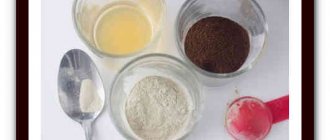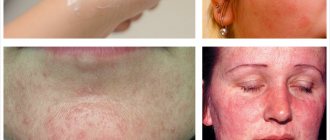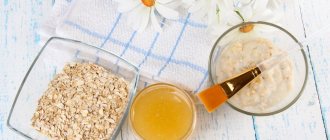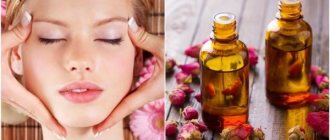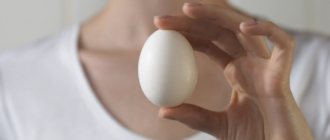A blue clay face mask at home is as effective as a procedure done by a professional cosmetologist. Why is this so? Blue clay is a natural material that is accessible and easy to use, helps fight pimples and inflammation, has a beneficial effect on the structure of the skin, making it smooth and elastic, and literally erases wrinkles from the face . There are several varieties of clay, the most valuable of which is blue or Cambrian clay.
When buying clay in a pharmacy, make sure that it consists of 100% natural blue clay and is highly purified; if the composition contains a mixture of different components, the effect may not be what you expect.
Blue clay is an ancient sedimentary rock formed about 550 million years ago during the Cambrian period. Due to the special conditions of formation and “solid” age, it has a rich mineral composition, including calcium, iron, phosphate, silica, nitrogen, zinc, magnesium, potassium and other elements valuable for the human body.
For the greatest effectiveness from a homemade face mask with blue clay, before starting a cosmetic procedure, you should follow these recommendations:
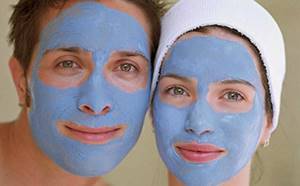
- Blue clay has virtually no contraindications , with the exception of extremely rare cases of individual intolerance. Be sure to do an allergy test: apply a small amount of the mixture to your wrist or inner elbow and observe for 15 minutes, there should be no irritation or itching.
- Clean and steam your face before applying the mask. It is best to make a steam bath with a decoction of chamomile or calendula.
- metal spoons or utensils to prepare the mask . Cambrian clay will lose some of its valuable properties from contact with metal.
- a clay mask for oily skin with heated water , and be sure to add emollient ingredients to the product for dry skin : peach or olive oil, kefir, cream or honey.
- Keep the mask on your face for 20-25 minutes. At this time, you need to relax your facial muscles as much as possible ; you cannot talk or laugh.
- A clay mask on your face may dry unevenly. If in some places the clay has dried out and tightened the skin, lightly moisten the mask with wet fingers or spray it with a spray bottle.
- When washing your face, do not rub your skin or use soap or foam ; carefully rinse the mask with warm water several times.
- A clay mask dries out the skin. After the procedure, apply a moisturizing or softening cream or facial oil.
Externally, blue clay is a fine powder, the color of which can have a grayish, brownish-green or bluish tint. When wet, it feels like wax or melted butter. Thanks to the unique combination of components, Cambrian clay has pronounced healing properties and is widely used for medical and cosmetic purposes.
Blue clay mask recipes
Mask for oily skin
- Place 30 grams of blue clay in a glass plate, add a teaspoon of warm water and stir until smooth.
- Beat the egg white from 1 egg well into a thick foam.
- Stirring gently, add the protein into the clay solution.
- Add 5 grams of sour cream with 15% fat content and mix again, and then apply the mixture to your face.
You should make a mask 1 or 2 times a week. To achieve a lasting effect, you will need to carry out 10 procedures.
Anti-inflammatory mask with essential oils and vitamins
https://www.youtube.com/watch?v=bsA9Wxl-Lyg
Nourishing rejuvenating mask for dry skin with egg and honey
- Place clay (20 grams) in a suitable container, pour in heated water (15 ml) and stir so that there are no lumps.
- Add 1 egg to the mixture (it must be removed from the refrigerator at least an hour before the procedure).
- Pour in 5 ml. olive oil, stir the ingredients.
- Heat honey (5 grams) in a microwave oven or in a water bath, add it to the mask and mix the product, and then apply to the skin.
After the procedure, be sure to lubricate your face with moisturizer. Carry out the treatment once every 7 days for two months.
Face mask made of honey and clay
There are several varieties of pharmaceutical clay, each of them has a beneficial effect on the skin of the face. White clay, also called kaolin, contains a lot of zinc, magnesium and silica. This clay is an excellent antiseptic and promotes skin regeneration. Kaolin stimulates metabolic processes in cells and cleanses the skin surface. White clay is suitable for oily, thin and dull skin. Kaolin makes it more elastic and smooth, relieves puffiness. Blue clay contains substances such as iron, phosphate, nitrogen, silica, aluminum, etc. This clay has a whitening, cleansing, disinfectant and anti-inflammatory effect on the skin. It improves metabolism and blood circulation, exfoliates the skin. Blue clay smoothes wrinkles and removes acne. Yellow clay contains a lot of potassium and iron. It perfectly helps dull and dull aging skin. Yellow clay has a tonic effect and, in case of inflammation, removes harmful toxins from the skin. Helps with acne, removes dead cells. Green clay is very rich in molybdenum, copper, cobalt, zinc, manganese, phosphorus, calcium, magnesium and silver. Saturates the skin with nutrients and rejuvenates it. Cleanses well and tightens pores, great for caring for oily skin. Green clay has tonic and regenerating properties, improves blood circulation. Smoothes and tightens the skin, makes it smoother, improves metabolic processes in cells. Relieves swelling and has an antibacterial effect. Red clay contains oxides of copper and iron. Saturates the skin with oxygen and improves blood circulation, eliminates allergic reactions. Red clay is best suited for sensitive and aging skin. Pink clay contains a large amount of silicon. It nourishes the skin and normalizes the functioning of its cells. Helps with skin irritation. Honey also serves as an excellent cosmetic product. It smooths out wrinkles, makes the skin velvety, cleanses and nourishes it. The beneficial properties of clay and honey can be combined in one mask. Take a teaspoon of thick and fresh uncandied honey, mix it with a teaspoon of your chosen clay. Dilute the mixture with one teaspoon of boiled water. Mix the mixture thoroughly. Apply the resulting mask to your face and leave for 10 minutes. Rinse off with warm water.
Whitening mask for age spots with blue clay and cucumber
This mask has a noticeable whitening effect and will help remove age spots or old pimple marks.
- Squeeze the juice from 1 fresh cucumber.
- 1 Beat the egg white to a strong foam.
- Place 20 grams of Cambrian clay in a suitable container, pour 20 ml of cucumber juice and whipped egg white into it.
- Add a pinch of salt to the mixture and stir.
To lighten your face using this method, you will need to carry out 2 to 5 procedures. You can repeat them every three days.
Favorite cleansing face masks from different clays from Tatyana, recipe for a blue clay mask
Blue clay + Neem oil.
Nourishing face mask made of blue clay with apple
The apple-mineral mixture has proven itself well; it helps in the fight against dry skin and loss of elasticity.
- Grate one apple into puree, mix with 2 tablespoons of the mineral and add a teaspoon of lemon juice.
- Mix the mask until smooth and apply to the skin until completely dry.
- Leave on face for 30-40 minutes, then rinse gently with hot water.
Moisturizing beauty mask
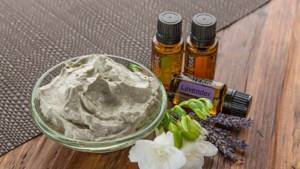
- It is prepared extremely simply and quickly: two tablespoons of blue clay are mixed with any cosmetic oil of your choice: olive, peach, rose; Apply the potion to the problem area and leave for half an hour.
This product helps to cope well with blackheads and can also be used to care for lips during the cold season.
A mixture of clay and mineral water
It can serve as an excellent tool for increasing elasticity and improving blood circulation in the epidermis.
- Mix one part of the mineral with two parts of water, apply a thick layer to the entire surface of the skin, avoiding contact with the eyes and mucous membranes. Wash off after 40 minutes.
An effective simple mask that leaves your facial skin smooth and velvety.
Chemical peeling from blue clay at home
With the help of clay, you can not only nourish your face, but also get rid of such unpleasant things as acne scars or enlarged pores . Nowadays, almond peeling for oily facial skin is a widely used service in beauty salons, which can also be done at home.
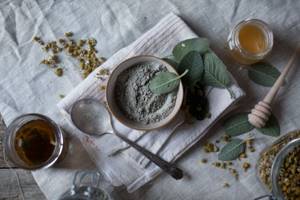
- For such a chemical effect you will need blue clay 2 spoons (Cambrian is best, but any other will do), almond oil 1 spoon, extract of cloves, black pepper and cinnamon, a few drops of everything.
- Mix all the ingredients until smooth and apply with a sponge to the face with light massage movements.
- Do not press, lightly wipe the skin, pay special attention to the T-zone (nose, forehead, cheeks) or chin, depending on the problem area. We continue these movements for five minutes.
- Wash off with warm water and make yourself your favorite nourishing mask.
Egyptian moisturizing mask
- For this remedy, which according to legend was used by Cleopatra, we will need milk and clay (2:1).
- Gently stir and apply a thin layer.
- Keep it on for about 20-30 minutes and wash.
- Can be used every day.
There is another recipe, all the ingredients are the same, but a teaspoon of honey and a couple of drops of lemon oil .
- A layer of normal thickness is applied for 15 minutes.
- Afterwards, to improve blood circulation, wash your face first with hot water, and then with cold water, repeat several times.
Blue clay mask for oily skin, smoothing wrinkles
Blue clay + almond oil
An astringent blue clay mask will help overcome enlarged pores
- 1 egg (white),
- not a cool clay mixture (sour cream state),
- spoon of lemon juice.
Keep it on your face for 20 minutes; to get a quick effect, use it two to three times a week.
Oatmeal with blue clay minerals will help whiten your skin
- Half a teaspoon of honey is mixed with half a spoon of lemon juice, added to the clay porridge and placed in a water bath.
- Apply to the face using a sponge or gauze bandage.
A similar recipe: add parsley (finely chopped), olive oil and lemon juice to the porridge. Keep it on your face for 15 minutes.
In this video you can see what happens when the blue clay mask dries on the skin:
To make masks more effective, you can mix them not with water, but with herbal infusions, such as sage or chamomile. Do not let the blue mask dry out, wash it off after 15 minutes, add suitable oils if you have dry skin, and then this mask will give you a pleasant sensation and a rejuvenating effect. Useful beauty to you!
A simple mask recipe for velvety facial skin! Clay and aloe work wonders!
Facial skin needs constant care. When we forget to additionally care for and nourish it, it responds to us with a dull complexion, uneven skin texture and swelling. No woman wants to be accompanied during the day by such companions who create the impression of untidiness and unkemptness.
To prevent these problems from occurring and always look fresh, we are sharing with you a recipe for a mask based on blue clay. The mask must be used once a week for 1 month. In fact, the effect will not keep you waiting, and you will see it instantly. It will definitely impress you. After the mask, the skin is smooth, velvety, soft, unevenness is smoothed out, the skin becomes moisturized.
The mask is suitable for dry, oily and combination skin. In this respect it is universal. By the way, as in solving many problems. And all aloe fans will love this mask.
About aloe
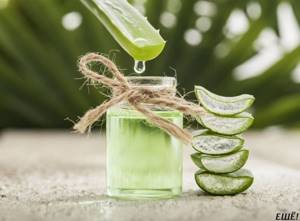
As you know, aloe contains a lot of vitamins and minerals. It will help remove all inflammation, heal wounds and even remove age spots from the face. Among the contraindications are “critical” days for women. Oddly enough, it is better to refrain from using it at this time. To prepare the mask you will need aloe juice. Before squeezing it from the leaf, you must first put the aloe in the refrigerator for a short time. Only after this do cosmetologists recommend squeezing out the juice and using it. The aloe vera substance will become viscous and thick. It will become more convenient to squeeze and use. To prepare the mask you will need about three tablespoons of juice.
About clay
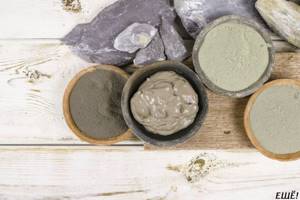
The second component in the mask is blue clay. This is the most popular clay among all, due to its rich composition and high efficiency. It perfectly cleanses pores and destroys bacteria. Many people are familiar with its action and even as a stand-alone product it works incredibly, making the skin very smooth and soft to the touch, soothing it. Those with oily skin will especially like it, as it absorbs sebum and improves the functioning of the sebaceous glands. Blue clay will help you achieve a fresh, healthy complexion, and in tandem with aloe juice they will cope with this task perfectly. To prepare the mask, you need to mix aloe juice with two tablespoons of blue clay. Clay can be used not only for the face, but also for the whole body, added to baths, and made anti-stone masks for the back.
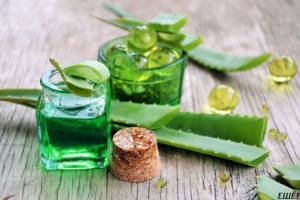
Aloe and clay face mask
Tip: If you have aloe extract at home, you can safely add a pinch to the mixture. You can replace it with another extract that suits your skin. The dosage for each extract is individual; read the manufacturer’s information on the packaging.
After you have mixed aloe juice and clay, you need to stir the mixture until the lumps disappear. To achieve this, dilute the mixture with 3-5 drops of water. Instead of water, you can take decoctions or herbal infusions. Then the mask will be even more effective. For example, chamomile decoction is perfect. If you drink herbal tea, you can use that. You can choose an essential oil if you know it suits you and add 2 drops to the mixture. It is not recommended to add more, as the essential oil can cause an allergic reaction or simply “burn” the face due to the high concentration in the mask.
Applying a mask
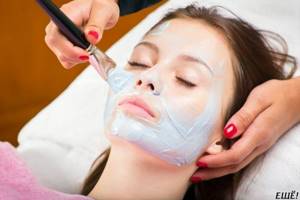
Before applying the mask, you need to prepare the skin itself. To do this, first clean it of makeup, wash with foam or soap, and dry with a towel. Apply the mask to dry skin. While using it, try not to use facial expressions or smile. The skin should be still and relaxed. After twenty minutes, the mask should be washed off with warm water. Do not use hot water. It should be a comfortable medium temperature.
After you have washed off the mask, you need to dry your skin with a towel and then apply moisturizer. You will immediately notice that the skin has become velvety and soft. Despite the amazing effect, you should not use the mask more than once a week. After a full course of procedures, your skin will be very grateful to you, and you will be very pleased with the result.
Adequate healthy sleep, good mood and food rich in vitamins will help maintain a healthy complexion and healthy appearance! Find out the recipe for a miracle serum that helps get rid of puffiness and dark circles under the eyes!
Blue clay for face. Properties.
Blue clay is a natural therapeutic and cosmetic product. It is well absorbed by our body. It is used not only for the face, but also for hair and body. Blue clay has absorbed the priceless gifts of nature; it contains: iron, calcium, potassium, nickel, chromium, cobalt, radium, magnesium and other trace elements.
- Clay has anti-inflammatory properties.
- Cleanses and whitens the skin, enhances skin metabolic processes.
- Cleanses and tightens pores on the face. Has disinfecting properties.
- I would like to note the fact that blue clay helps smooth out fine wrinkles.
- Strengthens, cleanses, nourishes.
- Absorbs waste and toxins.
- Blue clay perfectly dries the skin and helps get rid of acne.
- With regular use of clay masks, wounds heal, as clay has wound-healing healing properties.
- The skin is cleansed, the functioning of the sebaceous glands is restored to normal. For problem and oily skin, clay masks have a very good effect.
- The skin becomes smooth, firm and elastic.
Due to the healing properties of clay and its rich natural composition, cosmetologists use clay to prevent skin diseases, as well as for cosmetic imperfections. Before using this wonderful product, you should familiarize yourself with the indications and contraindications so as not to harm the skin.
How to make a mask from clay and milk
A clay and milk mask is made very quickly, easy to use and ideal for dry skin.
To prepare a mask at home you will need:
- Any clay - 2-3 spoons (blue is used in the recipe);
- Milk - 50 ml;
- Base oils (optional) - from a few drops to 2 tablespoons.
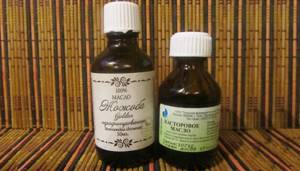
Cooking process:
- The clay must be poured into a ceramic or glass bowl. It is advisable not to use a metal spoon, but to take a wooden or plastic utensil. It is convenient to stir the clay either with a special stick or a sushi stick.
- You should add a little oil to the clay. You can use any oils depending on the characteristics and preferences of your skin. The recipe uses castor oil and jojoba oil.
- Next, pour 50 ml of warm milk or cream into the clay-oil mixture in a thin stream. The fat content of the product must be at least 2.5%. For particularly dry and chapped skin, it is better to take heavy cream.
- The mixture must be mixed carefully.
- You can add 15-20 mg of tocopherol (vitamin E). The use of esters and extracts is encouraged.
- The consistency of the mask should not be too liquid, but not too thick.
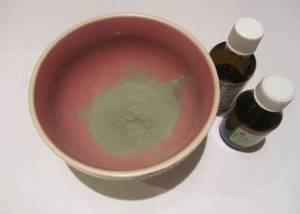
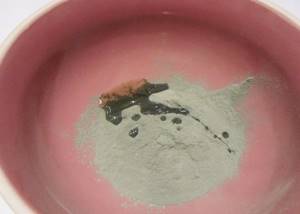
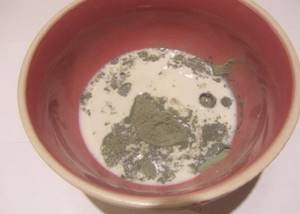
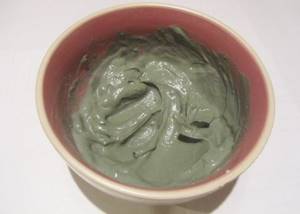
How to apply a clay mask?
- Before applying the mask, your facial skin must be thoroughly cleansed. It is best to first take a steam bath or massage your face well with a delicate scrub.
- Don't forget about the neck. It also needs to be cleaned. The mask is applied not only to the face, but also to the neck and décolleté.
- Before applying clay to your face, you need to hide your hair under a special bandage or towel.
- The clay mass must be applied to the face and neck in an even layer, avoiding the area around the eyes.
- As the clay mass dries, it should be moistened with water, this will protect the skin from a feeling of tightness and allow beneficial elements to penetrate deeper into the pores.
- Keep the mask on for at least 20 minutes.
- You can wash off the clay either with plain water or with herbal infusion. The second option is more effective and will give better results.
- To achieve the best effect, the procedure must be repeated regularly, once (and for more serious problems, twice) a week.
This clay and milk mask will not dry out already dry skin, but, on the contrary, will nourish and moisturize it. Due to the oils contained in the mask, a thin protective film will appear on the surface of the face, and the milk will even out the color of the dermis, giving it a velvety and healthy appearance. Experiment with clay and don’t be afraid of the consequences, as it is a completely natural and therefore safe product. Weekly clay masks will quickly make chapped, dry skin smooth, healthy and velvety.
Blue clay. Application for the face and contraindications
Since blue clay has healing properties, it is used for skin inflammation. It is suitable for oily and combination skin.
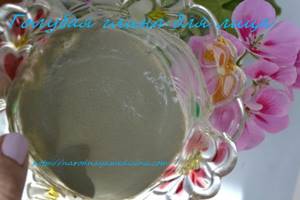
- Use blue clay for enlarged, contaminated pores on the face.
- And also for allergic skin rashes.
- You can use clay masks as nourishing ones, in combination with other components. It is useful to use during the period of vitamin deficiency, in the autumn and spring.
- Masks have a positive effect on irritated facial skin, acne, and pimples.
- Clay masks eliminate age spots on the skin.
- For sagging skin. Blue clay is used for skin that has lost firmness and elasticity.
Of course, with rashes, acne and blackheads, you need to approach everything comprehensively. Then you will be pleased with the result in the shortest possible time.
Blue clay masks are contraindicated in case of individual intolerance to clay or allergies to it. For sensitive skin, masks should be used with caution.
But in any case, before using the mask, test part of the mask on the skin; if there is no redness or irritation, the mask can be applied to the face. Moreover, for sensitive skin, the mask should not be applied for more than 10 minutes.
For dry and sensitive skin, add components to the mask that suit your skin type. Since clay draws out toxins, skin rashes may occur.


